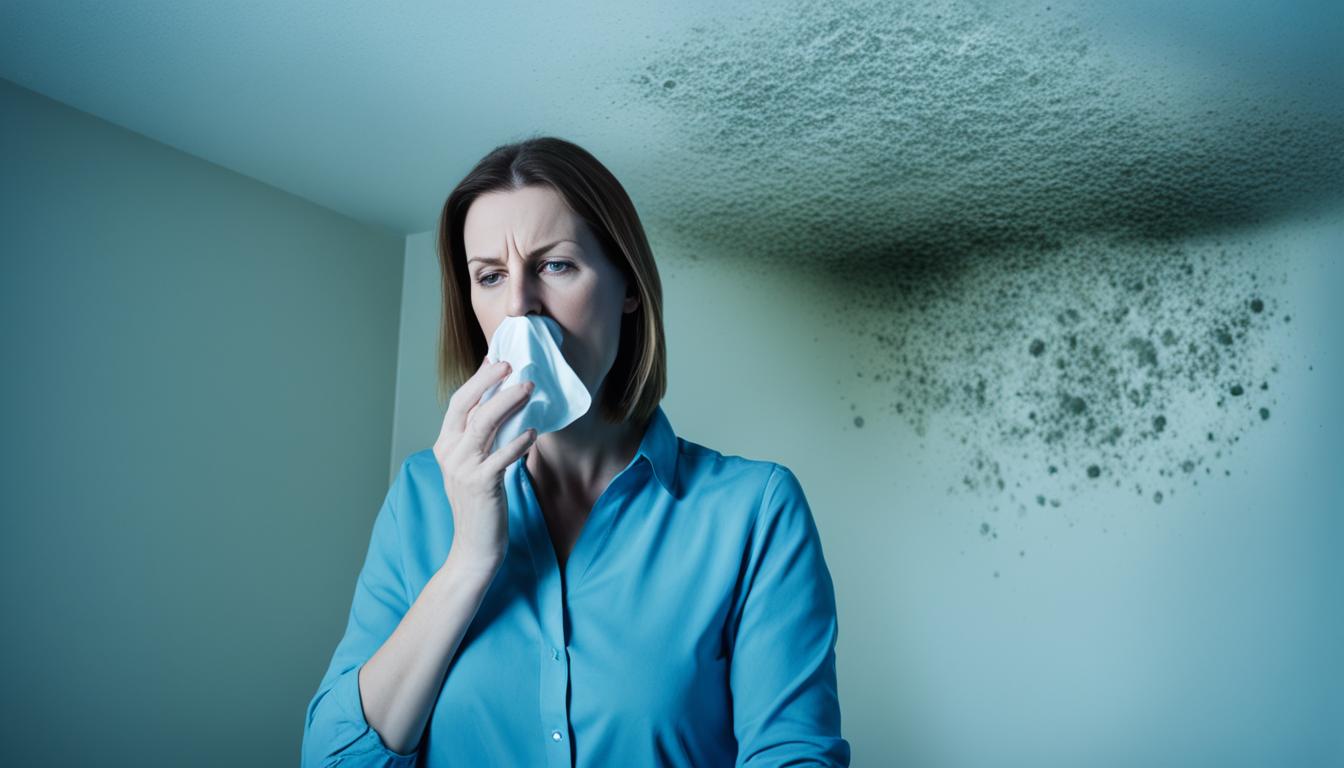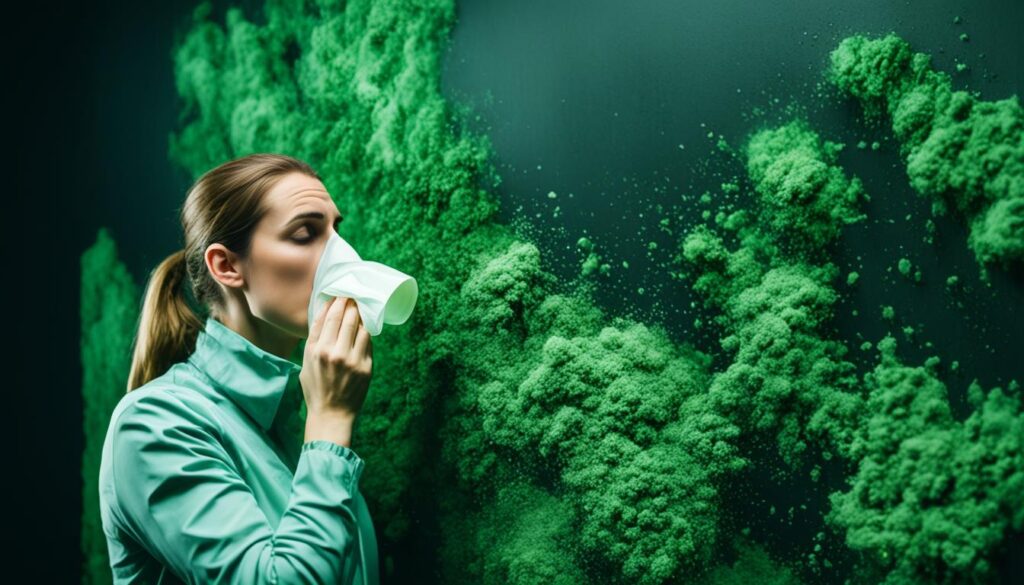
Mold Exposure Symptoms: What to Watch For
Welcome to our guide on mold exposure symptoms. Mold is a common problem that can potentially impact your health and well-being. It is essential to be aware of the signs and symptoms that indicate mold exposure, so you can take prompt action to protect yourself and your loved ones.
Exposure to mold can lead to a variety of health issues, ranging from respiratory problems to allergic reactions. By understanding these symptoms, you can detect and address mold-related issues early on.
Key Takeaways:
- Being aware of mold exposure symptoms is crucial for protecting your health.
- Mold exposure can lead to respiratory problems and allergic reactions.
- Prompt action is necessary to address mold-related health issues.
- Regularly monitoring your indoor environment can help prevent mold growth.
- Seeking professional assistance for mold assessment and remediation is recommended.
Recognizing the Signs of Mold Exposure
If you suspect that you or someone in your household has been exposed to mold, it’s crucial to be able to recognize the signs and symptoms associated with mold exposure. By understanding these indicators, you can take the necessary steps to protect your health and well-being.
Mold exposure can affect individuals differently, depending on various factors such as the type of mold, duration of exposure, and individual susceptibility. However, there are common symptoms that may indicate mold exposure:
- Respiratory Issues: Mold exposure can lead to respiratory problems such as coughing, wheezing, and shortness of breath. If you experience persistent respiratory symptoms, it’s important to consider the possibility of mold in your environment.
- Allergic Reactions: Many people develop allergic reactions when exposed to mold, including sneezing, runny nose, itchy eyes, and skin rashes. If these symptoms occur when you are indoors or in specific locations, mold exposure may be a contributing factor.
- Headaches and Fatigue: Mold exposure can also cause recurring headaches and unexplained fatigue. If you constantly feel tired or experience headaches without a clear cause, it’s worth investigating whether mold is present in your surroundings.
- Digestive Issues: Some individuals may experience digestive problems, such as nausea, vomiting, or diarrhea, as a result of mold exposure.
It’s important to note that these symptoms can also be caused by other factors, so it’s essential to consult a healthcare professional for an accurate diagnosis. They can help determine whether mold exposure is the underlying cause of your symptoms and guide you in the appropriate course of action.
“If you suspect that you or someone in your household has been exposed to mold, it’s crucial to be able to recognize the signs and symptoms associated with mold exposure.”
It’s worth mentioning that some individuals may be more sensitive to mold than others. People with underlying respiratory conditions, weakened immune systems, or allergies are generally more susceptible to experiencing severe symptoms from mold exposure.
By recognizing the signs of mold exposure, you can take proactive measures to address the issue. Whether it involves seeking professional assistance for mold testing and remediation or ensuring proper ventilation and humidity control in your home, early detection and intervention are key to safeguarding your health.

Final Thoughts
Mold exposure can have detrimental effects on your health, so it’s important to pay attention to any potential signs or symptoms. If you suspect mold in your environment, it’s best to consult with a professional to assess and address the issue promptly. Taking action can help ensure a safe and healthy living environment for you and your loved ones.
Health Effects of Mold Exposure
Exposure to mold can have significant health effects, impacting both physical and respiratory well-being. It is crucial to understand the dangers associated with mold exposure and take necessary precautions to protect yourself and your loved ones.
Respiratory Health: Mold spores, when inhaled, can cause respiratory issues such as coughing, wheezing, and shortness of breath. Individuals with pre-existing respiratory conditions like asthma may experience exacerbated symptoms in the presence of mold.
Allergic Reactions: Mold is known to trigger various allergic reactions. These can range from mild symptoms like sneezing, runny nose, and watery eyes to more severe reactions, including skin rashes and hives.
“Continuous exposure to mold can lead to long-term health complications, especially for individuals with compromised immune systems.” – Dr. Emily Thompson, Allergist
Mold exposure may also cause other symptoms such as headaches, fatigue, and difficulty concentrating. It is important to note that the severity of these health effects can vary depending on the individual, the type of mold, and the duration and intensity of exposure.
Preventing Mold-Related Health Issues
Reducing the risk of mold exposure is essential for safeguarding your health. Here are some preventive measures you can take:
- Maintain proper ventilation in your home, ensuring sufficient airflow.
- Keep indoor humidity levels below 50% to discourage mold growth.
- Fix any leaks or water damage promptly.
- Clean and dry areas prone to moisture, such as bathrooms and kitchens.
- Use mold-resistant materials and paints in areas susceptible to mold growth.
- Regularly inspect and clean HVAC systems, ensuring proper maintenance.
By following these guidelines and addressing any signs of mold growth promptly, you can minimize the risks associated with mold exposure and create a healthier living environment.
| Health Effects | Symptoms |
|---|---|
| Respiratory Issues | Coughing, wheezing, shortness of breath |
| Allergic Reactions | Sneezing, runny nose, watery eyes, skin rashes |
| Other Symptoms | Headaches, fatigue, difficulty concentrating |

Protecting Your Well-being
To protect yourself from mold exposure and prevent mold-related health issues, it is crucial to implement preventive measures and follow certain steps. By taking proactive action, you can safeguard your health and maintain a healthy indoor environment.
Firstly, it is essential to reduce mold growth by controlling moisture levels in your home. Ensure proper ventilation in areas prone to moisture, such as bathrooms and kitchens. Fix any leaks or water damage promptly to prevent mold from thriving.
Maintaining a clean and dry environment is also key to preventing mold. Regularly clean and dry any areas that are prone to moisture, such as window sills, basements, and air conditioning units. Use mold-resistant paint or additives to protect surfaces from mold growth.
Seeking professional assistance for mold assessment and remediation is crucial to effectively address any mold issues. Professionals can identify the source of mold, assess the extent of contamination, and provide the necessary remediation services to ensure proper removal and prevention of mold recurrence.




